Abstract
1. The effect of pyridoxalphosphate-6-azophenyl-2',4'-disulphonic acid (PPADS) on the relaxant response to adenine nucleotides was examined in the carbachol-contracted guinea-pig taenia coli and rat duodenum, two tissues possessing P2y-purinoceptors. In addition, in the taenia coli PPADS was investigated for its effect on relaxations evoked by adenosine, noradrenaline and electrical field stimulation. In order to assess the selectivity of PPADS between P2-purinoceptor blockade and ectonucleotidase activity, its influence on ATP degradation was studied in guinea-pig taenia coli. 2. The resulting rank order of potency for the adenine nucleotides in guinea-pig taenia coli was: 2-methylthio ATP >> ATP > alpha,beta-methylene ATP with the respective pD2-values 7.96 +/- 0.08 (n = 23), 6.27 +/- 0.12 (n = 21) and 5.88 +/- 0.04 (n = 24). 3. In guinea-pig taenia coli, PPADS (10-100 microM) caused a consistent dextral shift of the concentration-response curve (CRC) of 2-methylthio ATP and ATP resulting in a biphasic Schild plot. A substantial shift was only observed at 100 microM PPADS, the respective pA2-values at this particular concentration were 5.26 +/- 0.16 (n = 5) and 5.15 +/- 0.13 (n = 6). Lower concentrations of PPADS (3-30 microM) antagonized the relaxant effects to alpha,beta-methylene ATP in a surmountable manner. An extensive shift of the CRC was produced only by 30 microM PPADS (pA2 = 5.97 +/- 0.08, n = 6), and the Schild plot was again biphasic.(ABSTRACT TRUNCATED AT 250 WORDS)
Full text
PDF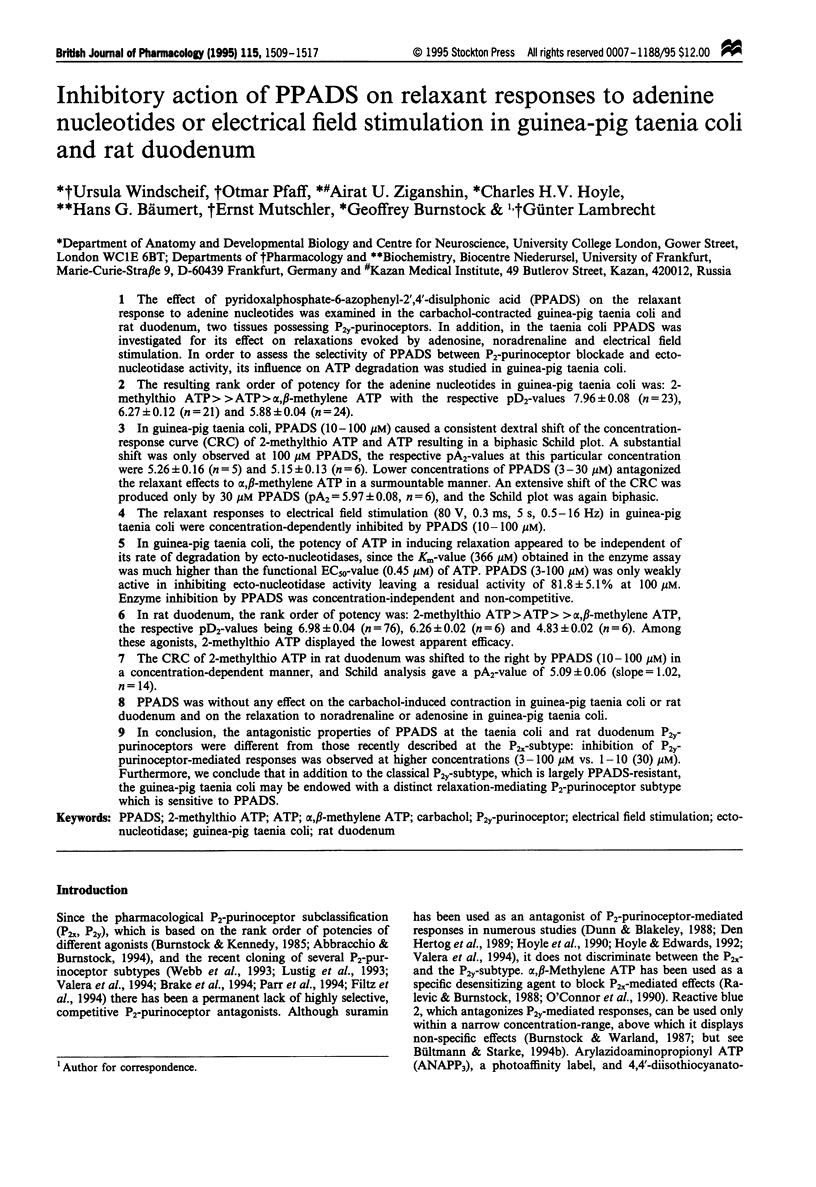
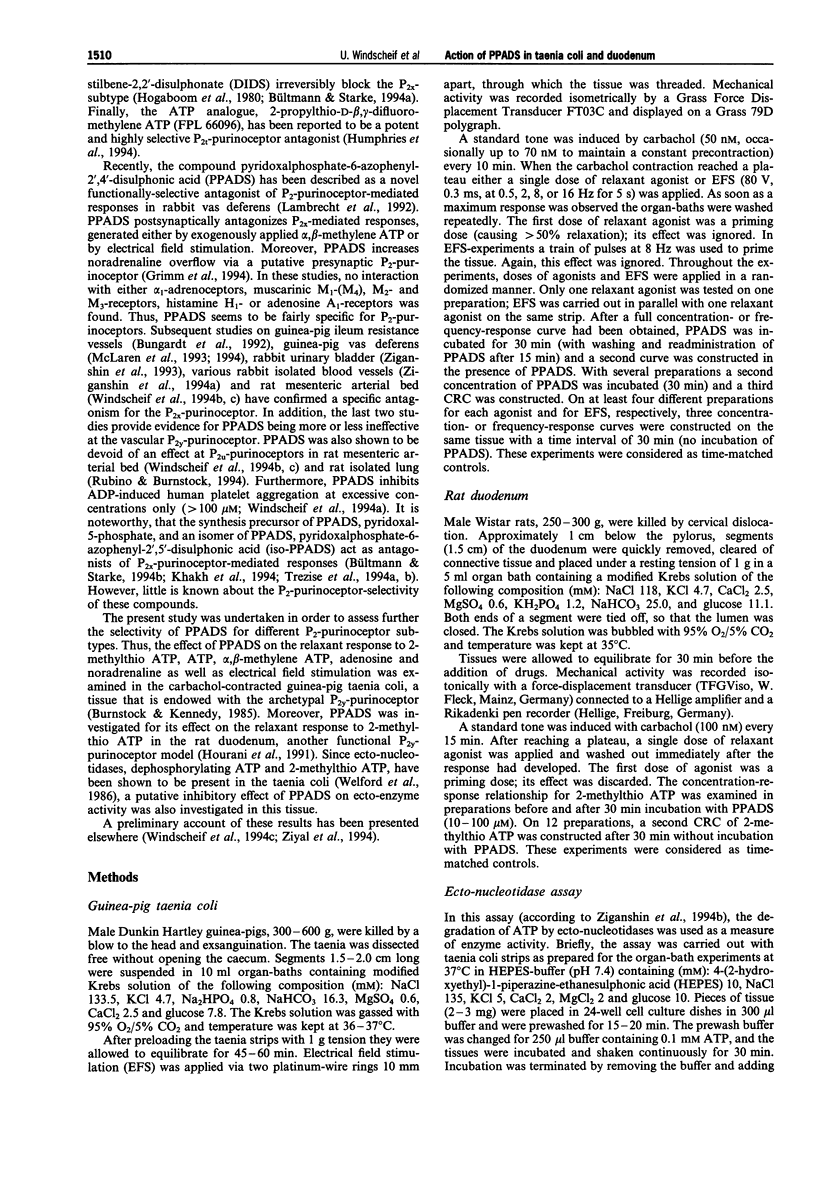
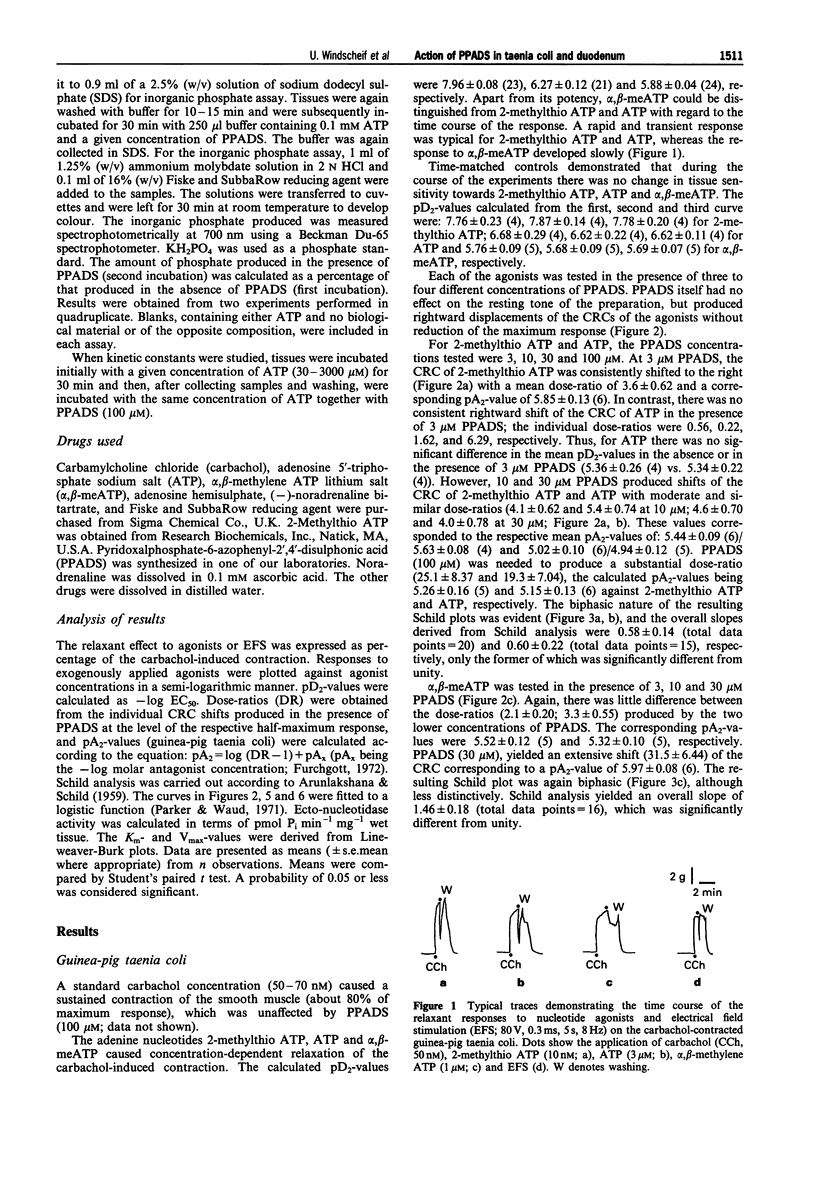

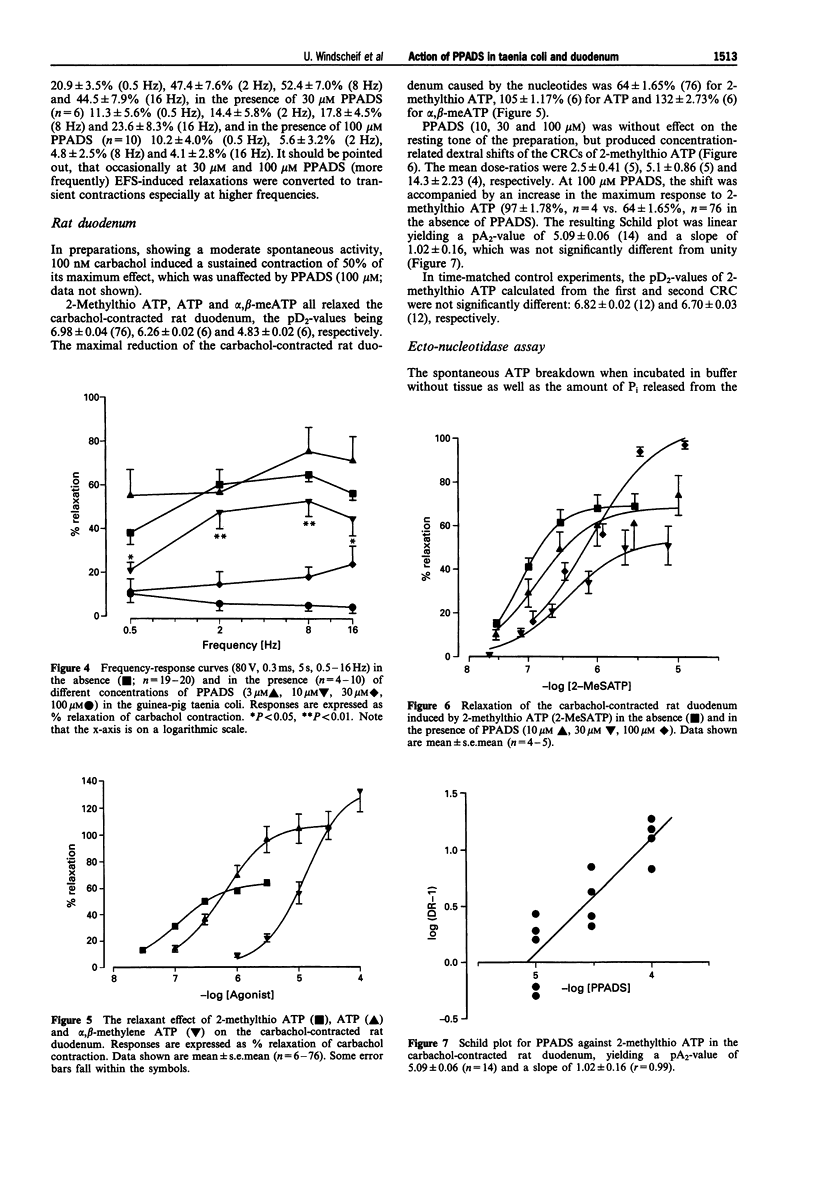
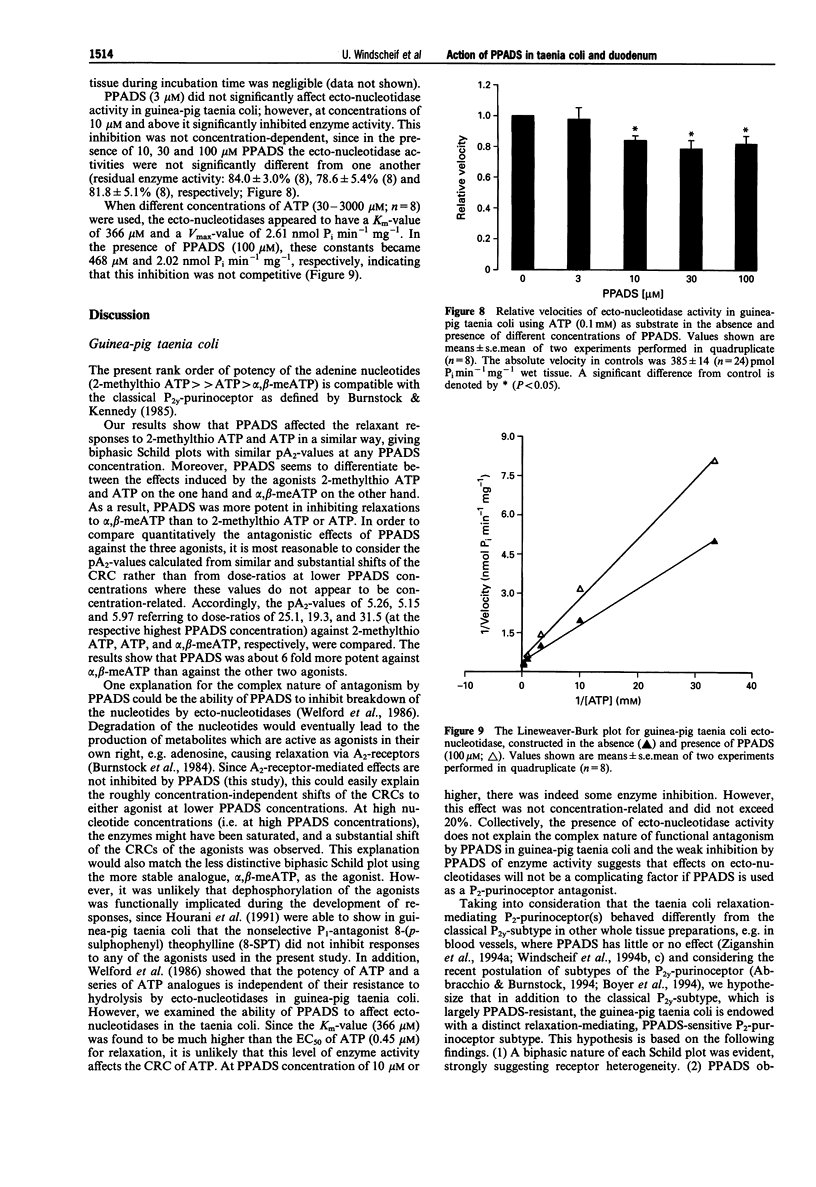
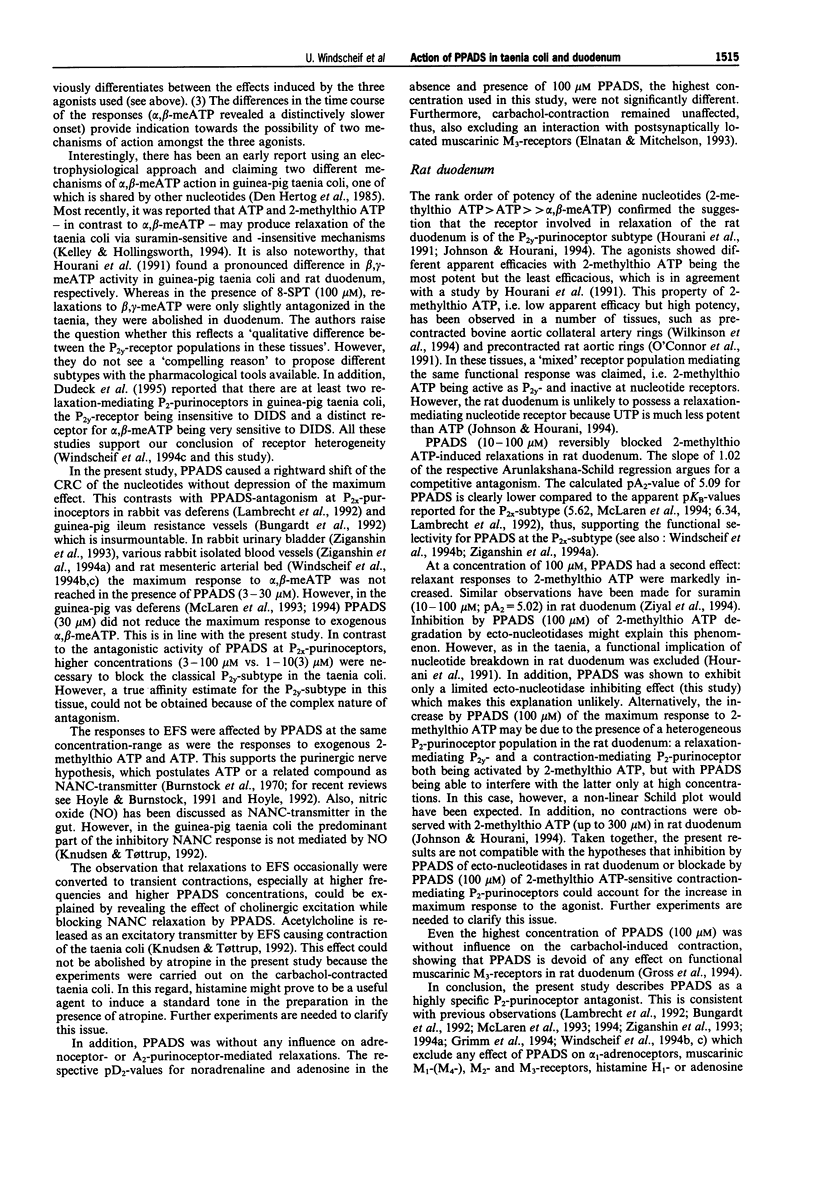
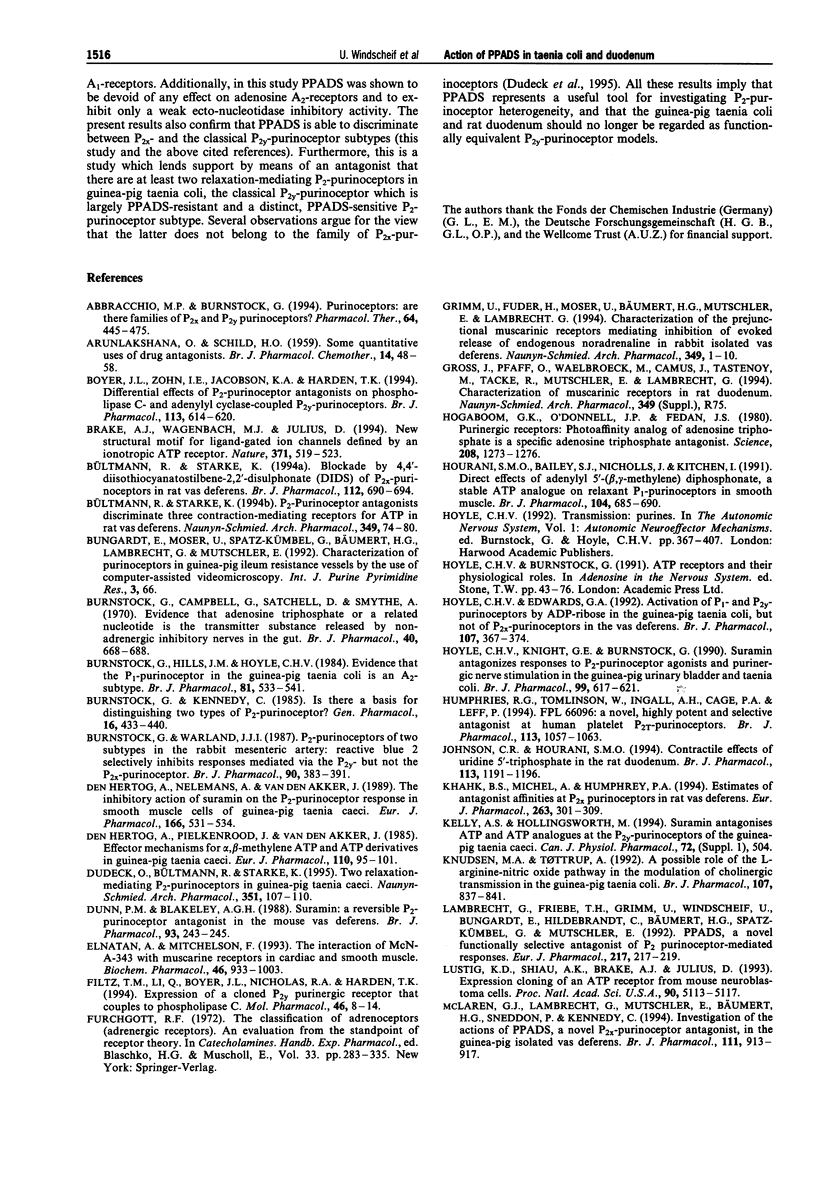
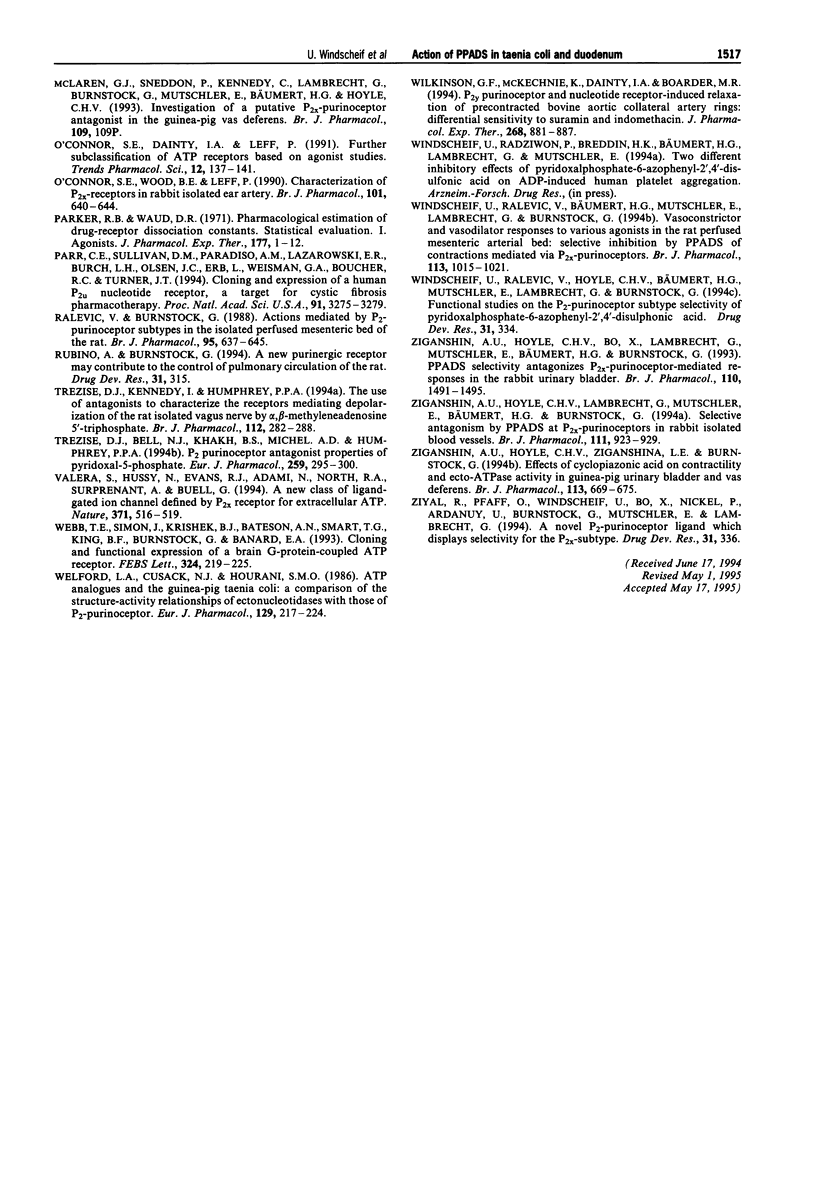
Selected References
These references are in PubMed. This may not be the complete list of references from this article.
- ARUNLAKSHANA O., SCHILD H. O. Some quantitative uses of drug antagonists. Br J Pharmacol Chemother. 1959 Mar;14(1):48–58. doi: 10.1111/j.1476-5381.1959.tb00928.x. [DOI] [PMC free article] [PubMed] [Google Scholar]
- Abbracchio M. P., Burnstock G. Purinoceptors: are there families of P2X and P2Y purinoceptors? Pharmacol Ther. 1994;64(3):445–475. doi: 10.1016/0163-7258(94)00048-4. [DOI] [PubMed] [Google Scholar]
- Boyer J. L., Zohn I. E., Jacobson K. A., Harden T. K. Differential effects of P2-purinoceptor antagonists on phospholipase C- and adenylyl cyclase-coupled P2Y-purinoceptors. Br J Pharmacol. 1994 Oct;113(2):614–620. doi: 10.1111/j.1476-5381.1994.tb17034.x. [DOI] [PMC free article] [PubMed] [Google Scholar]
- Brake A. J., Wagenbach M. J., Julius D. New structural motif for ligand-gated ion channels defined by an ionotropic ATP receptor. Nature. 1994 Oct 6;371(6497):519–523. doi: 10.1038/371519a0. [DOI] [PubMed] [Google Scholar]
- Burnstock G., Campbell G., Satchell D., Smythe A. Evidence that adenosine triphosphate or a related nucleotide is the transmitter substance released by non-adrenergic inhibitory nerves in the gut. Br J Pharmacol. 1970 Dec;40(4):668–688. doi: 10.1111/j.1476-5381.1970.tb10646.x. [DOI] [PMC free article] [PubMed] [Google Scholar]
- Burnstock G., Hills J. M., Hoyle C. H. Evidence that the P1-purinoceptor in the guinea-pig taenia coli is an A2-subtype. Br J Pharmacol. 1984 Mar;81(3):533–541. doi: 10.1111/j.1476-5381.1984.tb10106.x. [DOI] [PMC free article] [PubMed] [Google Scholar]
- Burnstock G., Kennedy C. Is there a basis for distinguishing two types of P2-purinoceptor? Gen Pharmacol. 1985;16(5):433–440. doi: 10.1016/0306-3623(85)90001-1. [DOI] [PubMed] [Google Scholar]
- Burnstock G., Warland J. J. P2-purinoceptors of two subtypes in the rabbit mesenteric artery: reactive blue 2 selectively inhibits responses mediated via the P2y-but not the P2x-purinoceptor. Br J Pharmacol. 1987 Feb;90(2):383–391. doi: 10.1111/j.1476-5381.1987.tb08968.x. [DOI] [PMC free article] [PubMed] [Google Scholar]
- Bültmann R., Starke K. Blockade by 4,4'-diisothiocyanatostilbene-2,2'-disulphonate (DIDS) of P2X-purinoceptors in rat vas deferens. Br J Pharmacol. 1994 Jun;112(2):690–694. doi: 10.1111/j.1476-5381.1994.tb13131.x. [DOI] [PMC free article] [PubMed] [Google Scholar]
- Bültmann R., Starke K. P2-purinoceptor antagonists discriminate three contraction-mediating receptors for ATP in rat vas deferens. Naunyn Schmiedebergs Arch Pharmacol. 1994 Jan;349(1):74–80. doi: 10.1007/BF00178209. [DOI] [PubMed] [Google Scholar]
- Den Hertog A., Pielkenrood J., Van den Akker J. Effector mechanisms for alpha,beta-methylene ATP and ATP derivatives in guinea-pig taenia caeci. Eur J Pharmacol. 1985 Mar 26;110(1):95–101. doi: 10.1016/0014-2999(85)90033-0. [DOI] [PubMed] [Google Scholar]
- Dudeck O., Bültmann R., Starke K. Two relaxation-mediating P2-purinoceptors in guinea-pig taenia caeci. Naunyn Schmiedebergs Arch Pharmacol. 1995 Jan;351(1):107–110. doi: 10.1007/BF00169071. [DOI] [PubMed] [Google Scholar]
- Dunn P. M., Blakeley A. G. Suramin: a reversible P2-purinoceptor antagonist in the mouse vas deferens. Br J Pharmacol. 1988 Feb;93(2):243–245. doi: 10.1111/j.1476-5381.1988.tb11427.x. [DOI] [PMC free article] [PubMed] [Google Scholar]
- Elnatan A., Mitchelson F. The interaction of McN-A-343 with muscarine receptors in cardiac and smooth muscle. Biochem Pharmacol. 1993 Sep 14;46(6):993–1003. doi: 10.1016/0006-2952(93)90663-h. [DOI] [PubMed] [Google Scholar]
- Filtz T. M., Li Q., Boyer J. L., Nicholas R. A., Harden T. K. Expression of a cloned P2Y purinergic receptor that couples to phospholipase C. Mol Pharmacol. 1994 Jul;46(1):8–14. [PubMed] [Google Scholar]
- Grimm U., Fuder H., Moser U., Bümert H. G., Mutschler E., Lambrecht G. Characterization of the prejunctional muscarinic receptors mediating inhibition of evoked release of endogenous noradrenaline in rabbit isolated vas deferens. Naunyn Schmiedebergs Arch Pharmacol. 1994 Jan;349(1):1–10. doi: 10.1007/BF00178199. [DOI] [PubMed] [Google Scholar]
- Hogaboom G. K., O'Donnell J. P., Fedan J. S. Purinergic receptors: photoaffinity analog of adenosine triphosphate is a specific adenosine triphosphate antagonist. Science. 1980 Jun 13;208(4449):1273–1276. doi: 10.1126/science.6103581. [DOI] [PubMed] [Google Scholar]
- Hourani S. M., Bailey S. J., Nicholls J., Kitchen I. Direct effects of adenylyl 5'-(beta,gamma-methylene)diphosphonate, a stable ATP analogue, on relaxant P1-purinoceptors in smooth muscle. Br J Pharmacol. 1991 Nov;104(3):685–690. doi: 10.1111/j.1476-5381.1991.tb12489.x. [DOI] [PMC free article] [PubMed] [Google Scholar]
- Hoyle C. H., Edwards G. A. Activation of P1- and P2Y-purinoceptors by ADP-ribose in the guinea-pig taenia coli, but not of P2X-purinoceptors in the vas deferens. Br J Pharmacol. 1992 Oct;107(2):367–374. doi: 10.1111/j.1476-5381.1992.tb12753.x. [DOI] [PMC free article] [PubMed] [Google Scholar]
- Hoyle C. H., Knight G. E., Burnstock G. Suramin antagonizes responses to P2-purinoceptor agonists and purinergic nerve stimulation in the guinea-pig urinary bladder and taenia coli. Br J Pharmacol. 1990 Mar;99(3):617–621. doi: 10.1111/j.1476-5381.1990.tb12979.x. [DOI] [PMC free article] [PubMed] [Google Scholar]
- Humphries R. G., Tomlinson W., Ingall A. H., Cage P. A., Leff P. FPL 66096: a novel, highly potent and selective antagonist at human platelet P2T-purinoceptors. Br J Pharmacol. 1994 Nov;113(3):1057–1063. doi: 10.1111/j.1476-5381.1994.tb17100.x. [DOI] [PMC free article] [PubMed] [Google Scholar]
- Johnson C. R., Hourani S. M. Contractile effects of uridine 5'-triphosphate in the rat duodenum. Br J Pharmacol. 1994 Dec;113(4):1191–1196. doi: 10.1111/j.1476-5381.1994.tb17123.x. [DOI] [PMC free article] [PubMed] [Google Scholar]
- Khakh B. S., Michel A., Humphrey P. P. Estimates of antagonist affinities at P2X purinoceptors in rat vas deferens. Eur J Pharmacol. 1994 Oct 3;263(3):301–309. doi: 10.1016/0014-2999(94)90726-9. [DOI] [PubMed] [Google Scholar]
- Knudsen M. A., Tøttrup A. A possible role of the L-arginine-nitric oxide pathway in the modulation of cholinergic transmission in the guinea-pig taenia coli. Br J Pharmacol. 1992 Nov;107(3):837–841. doi: 10.1111/j.1476-5381.1992.tb14533.x. [DOI] [PMC free article] [PubMed] [Google Scholar]
- Lambrecht G., Friebe T., Grimm U., Windscheif U., Bungardt E., Hildebrandt C., Bäumert H. G., Spatz-Kümbel G., Mutschler E. PPADS, a novel functionally selective antagonist of P2 purinoceptor-mediated responses. Eur J Pharmacol. 1992 Jul 7;217(2-3):217–219. doi: 10.1016/0014-2999(92)90877-7. [DOI] [PubMed] [Google Scholar]
- Lustig K. D., Shiau A. K., Brake A. J., Julius D. Expression cloning of an ATP receptor from mouse neuroblastoma cells. Proc Natl Acad Sci U S A. 1993 Jun 1;90(11):5113–5117. doi: 10.1073/pnas.90.11.5113. [DOI] [PMC free article] [PubMed] [Google Scholar]
- McLaren G. J., Lambrecht G., Mutschler E., Bäumert H. G., Sneddon P., Kennedy C. Investigation of the actions of PPADS, a novel P2x-purinoceptor antagonist, in the guinea-pig isolated vas deferens. Br J Pharmacol. 1994 Mar;111(3):913–917. doi: 10.1111/j.1476-5381.1994.tb14825.x. [DOI] [PMC free article] [PubMed] [Google Scholar]
- O'Connor S. E., Dainty I. A., Leff P. Further subclassification of ATP receptors based on agonist studies. Trends Pharmacol Sci. 1991 Apr;12(4):137–141. doi: 10.1016/0165-6147(91)90530-6. [DOI] [PubMed] [Google Scholar]
- O'Connor S. E., Wood B. E., Leff P. Characterization of P2x-receptors in rabbit isolated ear artery. Br J Pharmacol. 1990 Nov;101(3):640–644. doi: 10.1111/j.1476-5381.1990.tb14133.x. [DOI] [PMC free article] [PubMed] [Google Scholar]
- Parker R. B., Waud D. R. Pharmacological estimation of drug-receptor dissociation constants. Statistical evaluation. I. Agonists. J Pharmacol Exp Ther. 1971 Apr;177(1):1–12. [PubMed] [Google Scholar]
- Parr C. E., Sullivan D. M., Paradiso A. M., Lazarowski E. R., Burch L. H., Olsen J. C., Erb L., Weisman G. A., Boucher R. C., Turner J. T. Cloning and expression of a human P2U nucleotide receptor, a target for cystic fibrosis pharmacotherapy. Proc Natl Acad Sci U S A. 1994 Apr 12;91(8):3275–3279. doi: 10.1073/pnas.91.8.3275. [DOI] [PMC free article] [PubMed] [Google Scholar]
- Ralevic V., Burnstock G. Actions mediated by P2-purinoceptor subtypes in the isolated perfused mesenteric bed of the rat. Br J Pharmacol. 1988 Oct;95(2):637–645. doi: 10.1111/j.1476-5381.1988.tb11686.x. [DOI] [PMC free article] [PubMed] [Google Scholar]
- Trezise D. J., Bell N. J., Khakh B. S., Michel A. D., Humphrey P. A. P2 purinoceptor antagonist properties of pyridoxal-5-phosphate. Eur J Pharmacol. 1994 Jul 11;259(3):295–300. doi: 10.1016/0014-2999(94)90656-4. [DOI] [PubMed] [Google Scholar]
- Trezise D. J., Kennedy I., Humphrey P. P. The use of antagonists to characterize the receptors mediating depolarization of the rat isolated vagus nerve by alpha, beta-methylene adenosine 5'-triphosphate. Br J Pharmacol. 1994 May;112(1):282–288. doi: 10.1111/j.1476-5381.1994.tb13065.x. [DOI] [PMC free article] [PubMed] [Google Scholar]
- Valera S., Hussy N., Evans R. J., Adami N., North R. A., Surprenant A., Buell G. A new class of ligand-gated ion channel defined by P2x receptor for extracellular ATP. Nature. 1994 Oct 6;371(6497):516–519. doi: 10.1038/371516a0. [DOI] [PubMed] [Google Scholar]
- Webb T. E., Simon J., Krishek B. J., Bateson A. N., Smart T. G., King B. F., Burnstock G., Barnard E. A. Cloning and functional expression of a brain G-protein-coupled ATP receptor. FEBS Lett. 1993 Jun 14;324(2):219–225. doi: 10.1016/0014-5793(93)81397-i. [DOI] [PubMed] [Google Scholar]
- Welford L. A., Cusack N. J., Hourani S. M. ATP analogues and the guinea-pig taenia coli: a comparison of the structure-activity relationships of ectonucleotidases with those of the P2-purinoceptor. Eur J Pharmacol. 1986 Oct 7;129(3):217–224. doi: 10.1016/0014-2999(86)90431-0. [DOI] [PubMed] [Google Scholar]
- Wilkinson G. F., McKechnie K., Dainty I. A., Boarder M. R. P2Y purinoceptor and nucleotide receptor-induced relaxation of precontracted bovine aortic collateral artery rings: differential sensitivity to suramin and indomethacin. J Pharmacol Exp Ther. 1994 Feb;268(2):881–887. [PubMed] [Google Scholar]
- Windscheif U., Ralevic V., Bäumert H. G., Mutschler E., Lambrecht G., Burnstock G. Vasoconstrictor and vasodilator responses to various agonists in the rat perfused mesenteric arterial bed: selective inhibition by PPADS of contractions mediated via P2x-purinoceptors. Br J Pharmacol. 1994 Nov;113(3):1015–1021. doi: 10.1111/j.1476-5381.1994.tb17094.x. [DOI] [PMC free article] [PubMed] [Google Scholar]
- Ziganshin A. U., Hoyle C. H., Bo X., Lambrecht G., Mutschler E., Bäumert H. G., Burnstock G. PPADS selectively antagonizes P2X-purinoceptor-mediated responses in the rabbit urinary bladder. Br J Pharmacol. 1993 Dec;110(4):1491–1495. doi: 10.1111/j.1476-5381.1993.tb13990.x. [DOI] [PMC free article] [PubMed] [Google Scholar]
- Ziganshin A. U., Hoyle C. H., Lambrecht G., Mutschler E., Bümert H. G., Burnstock G. Selective antagonism by PPADS at P2X-purinoceptors in rabbit isolated blood vessels. Br J Pharmacol. 1994 Mar;111(3):923–929. doi: 10.1111/j.1476-5381.1994.tb14827.x. [DOI] [PMC free article] [PubMed] [Google Scholar]
- Ziganshin A. U., Hoyle C. H., Ziganshina L. E., Burnstock G. Effects of cyclopiazonic acid on contractility and ecto-ATPase activity in guinea-pig urinary bladder and vas deferens. Br J Pharmacol. 1994 Nov;113(3):669–674. doi: 10.1111/j.1476-5381.1994.tb17044.x. [DOI] [PMC free article] [PubMed] [Google Scholar]
- den Hertog A., Nelemans A., Van den Akker J. The inhibitory action of suramin on the P2-purinoceptor response in smooth muscle cells of guinea-pig taenia caeci. Eur J Pharmacol. 1989 Aug 3;166(3):531–534. doi: 10.1016/0014-2999(89)90370-1. [DOI] [PubMed] [Google Scholar]


